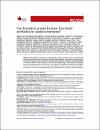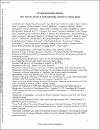Browsing Earth Science Cluster by Author "Lévesque, Esther"
Now showing items 1-4 of 4
-
Can bryophyte groups increase functional resolution in tundra ecosystems?
Lett, Signe; Jónsdóttir, Ingibjörg S.; Becker-Scarpitta, Antoine; Christiansen, Casper T.; During, Heinjo; Ekelund, Flemming; Henry, Gregory H.R.; Lang, Simone I.; Michelsen, Anders; Rousk, Kathrin; Alatalo, Juha M.; Betway, Katlyn R.; Rui, Sara B.; Callaghan, Terry; Carbognani, Michele; Cooper, Elisabeth J.; Cornelissen, J. Hans C.; Dorrepaal, Ellen; Egelkraut, Dagmar; Elumeeva, Tatiana G.; Haugum, Siri V.; Hollister, Robert D.; Jägerbrand, Annika K.; Keuper, Frida; Klanderud, Kari; Lévesque, Esther; Liu, Xin; May, Jeremy; Michel, Pascale; Mörsdorf, Martin; Petraglia, Alessandro; Rixen, Christian; Robroek, Bjorn J.M.; Rzepczynska, Agnieszka M.; Soudzilovskaia, Nadejda A.; Tolvanen, Anne; Vandvik, Vigdis; Volkov, Igor; Volkova, Irina; van Zuijlen, Kristel... more authors ... less authors ( Canadian Science Publishing , 2022 , Article Review)The relative contribution of bryophytes to plant diversity, primary productivity, and ecosystem functioning increases towards colder climates. Bryophytes respond to environmental changes at the species level, but because ... -
Effects of Climate and Atmospheric Nitrogen Deposition on Early to Mid-Term Stage Litter Decomposition Across Biomes
Kwon, Taeoh; Shibata, Hideaki; Kepfer-Rojas, Sebastian; Schmidt, Inger K.; Larsen, Klaus S.; Beier, Claus; Berg, Björn; Verheyen, Kris; Lamarque, Jean Francois; Hagedorn, Frank; Eisenhauer, Nico; Djukic, Ika; Caliman, Adriano; Paquette, Alain; Gutiérrez-Girón, Alba; Petraglia, Alessandro; Augustaitis, Algirdas; Saillard, Amélie; Ruiz-Fernández, Ana Carolina; Sousa, Ana I.; Lillebø, Ana I.; Da Rocha Gripp, Anderson; Lamprecht, Andrea; Bohner, Andreas; Francez, André Jean; Malyshev, Andrey; Andrić, Andrijana; Stanisci, Angela; Zolles, Anita; Avila, Anna; Virkkala, Anna Maria; Probst, Anne; Ouin, Annie; Khuroo, Anzar A.; Verstraeten, Arne; Stefanski, Artur; Gaxiola, Aurora; Muys, Bart; Gozalo, Beatriz; Ahrends, Bernd; Yang, Bo; Erschbamer, Brigitta; Rodríguez Ortíz, Carmen Eugenia; Christiansen, Casper T.; Meredieu, Cline; Mony, Cendrine; Nock, Charles; Wang, Chiao Ping; Baum, Christel; Rixen, Christian; Delire, Christine; Piscart, Christophe; Andrews, Christopher; Rebmann, Corinna; Branquinho, Cristina; Jan, Dick; Wundram, Dirk; Vujanović, Dušanka; Adair, E. Carol; Ordóñez-Regil, Eduardo; Crawford, Edward R.; Tropina, Elena F.; Hornung, Elisabeth; Groner, Elli; Lucot, Eric; Gacia, Esperança; Lévesque, Esther; Benedito, Evanilde; Davydov, Evgeny A.; Bolzan, Fábio Padilha; Maestre, Fernando T.; Maunoury-Danger, Florence; Kitz, Florian; Hofhansl, Florian; Hofhansl, G.; De Almeida Lobo, Francisco; Souza, Franco Leadro; Zehetner, Franz; Koffi, Fulgence Kouam; Wohlfahrt, Georg; Certini, Giacomo; Pinha, Gisele Daiane; Gonzlez, Grizelle; Canut, Guylaine; Pauli, Harald; Bahamonde, Héctor A.; Feldhaar, Heike; Jger, Heinke; Serrano, Helena Cristina; Verheyden, Hlne; Bruelheide, Helge; Meesenburg, Henning; Jungkunst, Hermann; Jactel, Hervé; Kurokawa, Hiroko; Yesilonis, Ian; Melece, Inara; Van Halder, Inge; Quirós, Inmaculada García; Fekete, Istvn... more authors ... less authors ( Frontiers Media , 2021 , Article)Litter decomposition is a key process for carbon and nutrient cycling in terrestrial ecosystems and is mainly controlled by environmental conditions, substrate quantity and quality as well as microbial community abundance ... -
Plant traits poorly predict winner and loser shrub species in a warming tundra biome
García Criado, Mariana; Myers-Smith, Isla H.; Bjorkman, Anne D.; Normand, Signe; Blach-Overgaard, Anne; Thomas, Haydn J.D.; Eskelinen, Anu; Happonen, Konsta; Alatalo, Juha M.; Anadon-Rosell, Alba; Aubin, Isabelle; te Beest, Mariska; Betway-May, Katlyn R.; Blok, Daan; Buras, Allan; Cerabolini, Bruno E.L.; Christie, Katherine; Cornelissen, J. Hans C.; Forbes, Bruce C.; Frei, Esther R.; Grogan, Paul; Hermanutz, Luise; Hollister, Robert D.; Hudson, James; Iturrate-Garcia, Maitane; Kaarlejärvi, Elina; Kleyer, Michael; Lamarque, Laurent J.; Lembrechts, Jonas J.; Lévesque, Esther; Luoto, Miska; Macek, Petr; May, Jeremy L.; Prevéy, Janet S.; Schaepman-Strub, Gabriela; Sheremetiev, Serge N.; Siegwart Collier, Laura; Soudzilovskaia, Nadejda A.; Trant, Andrew; Venn, Susanna E.; Virkkala, Anna Maria... more authors ... less authors ( Springer , 2023 , Article)Climate change is leading to species redistributions. In the tundra biome, shrubs are generally expanding, but not all tundra shrub species will benefit from warming. Winner and loser species, and the characteristics that ... -
The tundra phenology database: More than two decades of tundra phenology responses to climate change
Prevéy, Janet; Elmendorf, Sarah; Bjorkman, Anne; Alatalo, Juha; Ashton, Isabel; Assmann, Jakob; Björk, Robert G.; Björkman, Mats P.; Cannone, Nicoletta; Carbognani, Michele; Chisholm, Chelsea; Clark, Karin; Collins, Courtney; Cooper, Elisabeth J; Elberling, Bo; Frei, Esther; Henry, Greg H.R.; Hollister, Robert D.; Høye, Toke; Jónsdóttir, Ingibjörg Svala; Kerby, Jeff; Klanderud, Kari; Kopp, Christopher; Lévesque, Esther; Mauritz, Marguerite; Molau, Ulf; Myers-Smith, Isla; Natali, Susan; Oberbauer, Steve; Panchen, Zoe; Petraglia, Alessandro; Post, Eric; Rixen, Christian; Rodenhizer, Heidi; Rumpf, Sabine; Schmidt, Niels Martin; Schuur, Edward; Semenchuk, Philipp; Smith, Jane; Suding, Katherine; Toteland, Orjan; Troxler, Tiffany; Wahren, Henrik; Welker, Jeffery; Wipf, Sonja; Yang, Yue... more authors ... less authors ( NRC Research Press , 2021 , Article)Observations of changes in phenology have provided some of the strongest signals of the effects of climate change on terrestrial ecosystems. The International Tundra Experiment (ITEX), initiated in the early 1990s, established ...





